
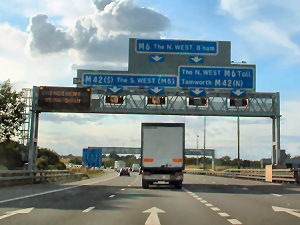 You can take driving lessons on UK motorways before you pass your test, but you must be with a fully-qualified driving instructor in a dual-controlled car.
You can take driving lessons on UK motorways before you pass your test, but you must be with a fully-qualified driving instructor in a dual-controlled car.
Many drivers believe that motorways are more dangerous than other roads - this is not true!
Mile-for-mile, there are fewer accidents on motorways than on other roads; probably because many of the hazards found on ordinary roads do not exist on motorways.
For example, there are no traffic lights, crossroads, T-junctions, parked cars, roundabouts, oncoming traffic, sharp bends, steep hills, pedestrians, cyclists, and very few slow-moving vehicles.
You can find additional information and videos on the National Highways Motorway website.
Don't set out on a motorway journey if you feel tired or ill. If you feel tired during your motorway journey, open the windows for fresh air. If this doesn't help, leave the motorway at the next exit and take a short walk.
Your vehicle should always be in good condition, but this becomes more important than ever on long motorway trips. If you are making a long journey, check your oil, water and tyre pressures before you set out. And, of course - make sure that you have enough fuel!
Breakdowns are rare in modern vehicles, and even though motorways are safer than other roads, they are probably the most dangerous place to be if you break down or run out of fuel.
Although motorways are our safest roads, when accidents happen, they are often quite severe due to the higher speeds involved.
You can significantly reduce your risk on the motorway by taking lessons with your instructor and following the advice given here.
This video is provided courtesy of Richard at Conquer Driving - you can find lots more on his You Tube channel...
The images below do not show all motorway signs, however, if you know these signs you will easily be able to work out the meaning of similar signs.
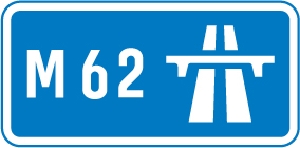

The first sign above tells you that you are entering a motorway - it is usually found at the start of a slip road. The second sign shows the end of the motorway (this example shows that the motorway ends in one mile).
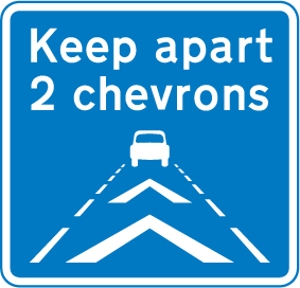
If you ignore this sign you could end up in a multi-vehicle smash. The gap might seem very big - but that's how long you will need to stop safely.
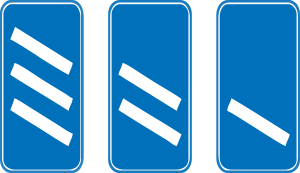
These countdown markers are placed 300, 200 and 100 metres before a motorway exit road.
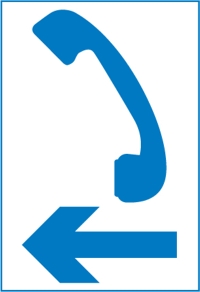
This small plate is fitted to the marker posts at the back of the hard shoulder - they show the direction to the nearest emergency telephone (essential if there is no mobile signal).
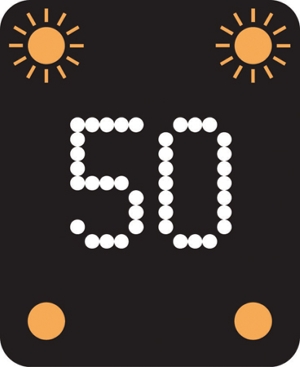
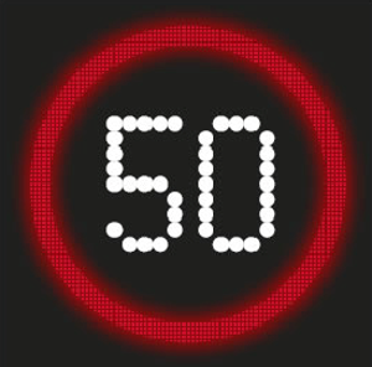
These speed limit signs show on overhead gantry. If there is a red circle around the sign it is compulsory (the first sign shown is advisory). Keeping to speed limits helps to reduce traffic hold-ups.

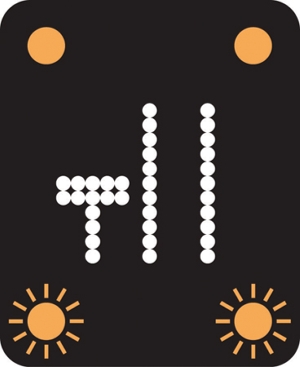
These are example of lane closure signs. The vertical lights indicate the lanes. The horizontal lights show which lanes are closed.

This sign is self-explanatory! There could be other warnings, For example 'ice'.
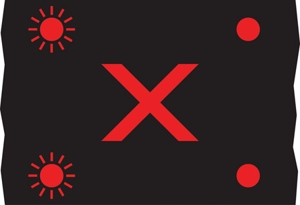
A red X over your lane indicates that the lane is closed. If all lanes have red X's the motorway is closed. You must not proceed in a lane that has a red X.

This arrow tells you to move to the next lane on the left (or right if reversed) these signs often show up to a mile before a red X to ensure that you can change lanes early.

You must leave the motorway at the next exit (this would show over all lanes)..

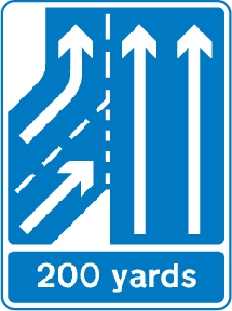
These are example of lane information signs

These often come up in pub quizzes! The shapes are included on other signs to show specific diversions when a motorway is closed. Different shapes are needed because some diversions might take different routes for different destinations. Alternatively, the shapes might indicate a route for certain vehicles (for example, some routes might not be suitable for tall or long vehicles).
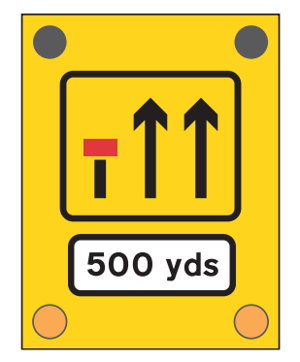
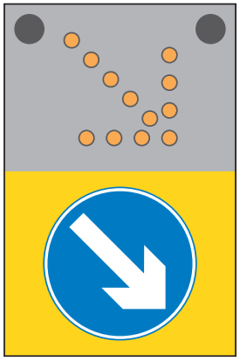
These are 'mobile road works' signs and are mounted on the back of trucks. Some road works such as clearing litter and debris are not static - the workers move along the carriageway. You must change lanes in the direction of the arrow.
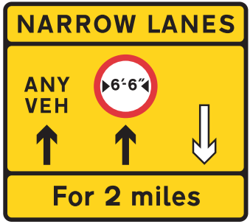
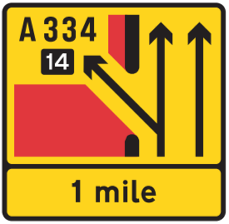
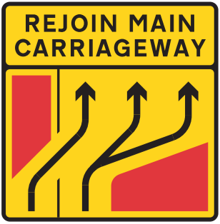
These are examples of lane signs at roadworks.
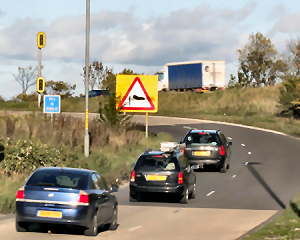
You usually join the motorway from a slip road and an acceleration lane. At other times you might join from a roundabout or by simply continuing on a dual-carriageway that becomes a motorway.
When joining the motorway via a slip road, it's important to remember that you are the 'odd one out' – the one who has to fit in with the flow.
Build up your speed on the slip road to match the speed of the traffic on the motorway. Doing this is essential, otherwise, you will become a hazard to yourself and other drivers as you try to fit in with fast-moving traffic.
As you're building up your speed on the slip road, check your mirrors and signal to the right to show that you intend to join the motorway.
Some people will argue that it shouldn't be necessary to signal. After all, when heading down a one-way slip road at 60mph, where else will you go?
But... Your signal is vital for these reasons:
It warns drivers behind that you are about to move out and that they should not try to overtake.
It alerts drivers who might be daydreaming and who might not see you.
It satisfies the 'idiot expert' drivers who believe, "If you don't give a signal, you've no right to 'push in front' of me".
The idea of anyone 'pushing in front' is a crazy notion on any road. With over 30 million vehicles on UK roads, there are always millions in front, and behind. Another one will make little or no difference to your journey time (at worst, a few seconds!).
As you drive down the slip road, you need to look for your gap in the traffic.
A helpful tip here is to decide which vehicle you want to follow rather than which vehicle you intend to drive in front of. This will help to keep your attention on the road ahead and help you to adjust your speed.
As you approach the main carriageway, you will enter an 'acceleration lane'. In the acceleration lane, you make final adjustments to your speed as you prepare to merge with the traffic in lane one (the left-hand lane).
Make sure that you check all of your mirrors.
A quick glance in the left mirror to look for 'idiots' overtaking on the left, a glance in the centre mirror to find out who is following and a couple of glances in the right door mirror to check that your gap is still available.
At this point, you might also benefit from a quick look over your right shoulder to double-check that there are no dangers in the right blind-spot area.
Some experts disagree with the idea of a final shoulder check (blind spot check), saying that it can distract you from the road ahead.
Travelling 70 mph you will be distracted from the road ahead for a distance of about 16 metres if your check takes half a second. But if you are using the 'two-second rule' (explained in this lesson) you will be around 64 metres between your vehicle and the vehicle in front – travelling 'blind' for 20 metres should not be a problem.
Take our advice. Glance back to check your blind spot.
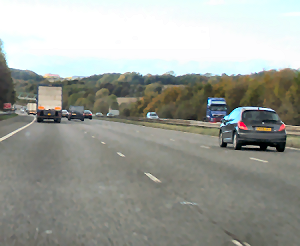 When you join the motorway, it's a good idea to stay in lane one for a while to get used to the higher traffic speeds.
When you join the motorway, it's a good idea to stay in lane one for a while to get used to the higher traffic speeds.
The standard motorway driving rule is to use the left-hand lane unless you are overtaking. But keep looking for road signs and markings that might direct you to a different lane. Sometimes, the left-hand lane might lead away from your intended destination, especially in places where motorways merge. (Highway Code Rule 246)
Although the basic rule for lane use on motorways is 'drive in the left-hand lane unless overtaking'. It's incredible how such as simple rule seems to be misunderstood by so many drivers! Can it be so difficult?
They could be a few reasons why some drivers don't keep to the rules:
Perhaps they don't know the rules.
Maybe they are just lazy, and it's too much trouble to look in the mirror and move the steering wheel a quarter of an inch.
It could be that they are afraid: "I'm in this lane, I'm in a straight line, and I'm staying here!"
Perhaps some drivers think: "The speed limit is 70, so no one can pass me - I'm being a good citizen by holding up other drivers".
Whatever the reasons others have for driving dangerously, it makes sense for you to adopt good lane discipline. Sticking to the rules will help the traffic flow and reduce accident risks by lowering frustration levels.
Just because you think 70mph is fast enough for anyone, it doesn't mean that the driver behind the sports car will feel the same thing. Let them go - that way you won't be involved in their accident!
Another reason for good lane discipline is to help truck drivers. When you are sitting in the middle lane at 45mph going up a slight incline, it's hardly surprising that the truck driver behind gets frustrated.
 Trucks take much longer to build up their speed and need to maintain the momentum to climb even the slightest inclines. Along with buses and vehicles towing trailers*, lorry drivers cannot use the right-hand lane (lane three), so they can't overtake you. Added to this, they're probably working to some impossible time deadline!
Trucks take much longer to build up their speed and need to maintain the momentum to climb even the slightest inclines. Along with buses and vehicles towing trailers*, lorry drivers cannot use the right-hand lane (lane three), so they can't overtake you. Added to this, they're probably working to some impossible time deadline!
* If you are towing a trailer, even a small garden or camping trailer, you cannot use lane-three and are limited to 60 mph.
Allow plenty of time for your actions on the motorway.
'Allow plenty of time for your actions' means managing the speed and space around your vehicle. One of the best ways to do this is to use the 'two-second rule' - you can find out about this and other ways to manage space by clicking here.
Some motorways have 'chevron' road markings to help you measure a safe following distance (see the chevrons sign image).
Sometimes, two chevrons distance seems very long - but whether you believe it or not, that's the kind of distance you need to stop in a sudden emergency.

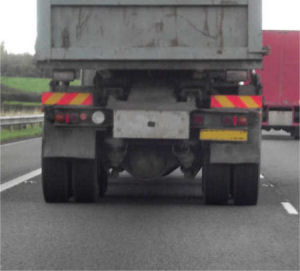
Overtaking is easy on motorways. You just need allow yourself lots of space and time.
Start your overtake manoeuvre early and well back from the vehicle you wish to pass. the nearer you get, the harder it will be to pull out, because you won't have enough space.
If the view in the picture is what you see before overtaking, you are at least 100 metres too close!
If you follow this closely, you will have no chance of a safe overtake - you have no space to build up your speed to pull out safely and added to this, truck drivers won't be able to see you in their mirrors and will not be aware that you are behind.
Give your signal early and allow it to flash a few times before starting to move - this will tell drivers behind what you intend to do.
Many drivers leave the signal until they have started the manoeuvre. They start moving out before signalling. Their signal tells you nothing when they do this because you can already see that they are beginning to move out. But, on second thoughts, maybe the signal does tell you something. It warns you that the driver is not paying full attention!
After signalling, check your mirrors and right blind spot before moving out.
When you have passed the vehicle you are overtaking and can see it in your centre mirror, move back to your original lane. A signal might be helpful - especially if moving from lane three to lane two.
Cancel your signal!
Make sure to cancel your signal after changing lanes; there won't be enough steering action to self-cancel the signal. Because of road noise or your favourite motorway driving playlist, you might not hear the indicator clicks, so cancelling the indicator is a positive 'must check' part of your routine.
If you are moving back in after overtaking a signal should not be needed because there will be plenty of time for others to see what you are doing. But as with joining the motorway, there might be others that need a 'wake-up call' or those who are stupid enough to accelerate if they see a driver start to move without a signal.
A good 'rule' for motorway signals is: 'If in doubt, give a signal'.
But.
Never signal out of 'habit'. Signals given without proper thought are always potentially dangerous, especially when travelling at high speed.
For extra safety when overtaking, never put yourself in a position where there is no escape route.
For example, if you are in lane three overtaking a lorry in lane two, avoid getting stuck alongside it - make sure there is plenty of room to get past it before you start to overtake.
In the example shown in the photo, the driver of the car in Lane 3 should avoid driving alongside the trucks. In this situation, hang back until you are 100% sure that you can pass the truck in lane two.
An easy way to think about this is to imagine a 'moving yellow box'.
You must never enter a yellow box unless your exit is clear. Imagine a moving yellow box ahead, and you will avoid getting stuck alongside a lorry.
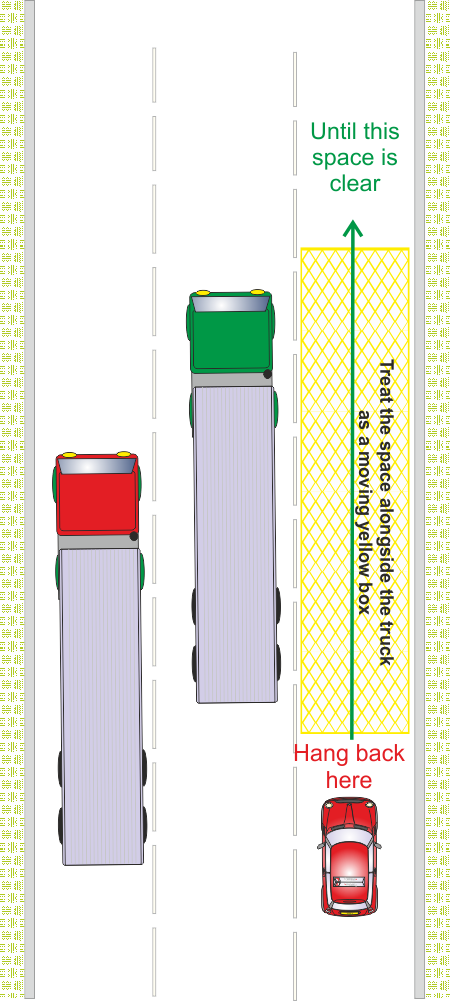
You will usually leave the motorway via an exit slip road.
If you have planned your journey well, your first job will be to look out for the exit number.
The exit number is in a black square with white numbers on the bottom left of the exit direction signs. The first direction sign for your junction is one mile before the exit and has the road numbers and the junction number, but it will not have the names of the destination.
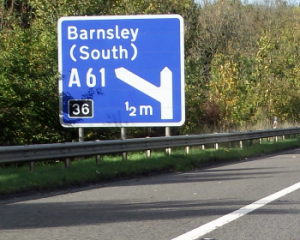 The second direction sign is similar to the first, but this sign includes place names. The sign in the picture is positioned half a mile before the junction.
The second direction sign is similar to the first, but this sign includes place names. The sign in the picture is positioned half a mile before the junction.
By the time you reach the second sign, you should be thinking of moving back to the left-hand lane if you are not already there. You need to be in the left lane well before the start of the deceleration lane.
Information is also shown on gantry signs at some junctions.
Finally, you will see the countdown markers. These are placed 270, 180 and 90 metres from the deceleration lane's start.
As you pass the first countdown marker, signal your intention to leave the motorway but maintain your speed - you can slow down in the deceleration lane and on the slip road.
As soon as you enter the slip road, check your speedometer; you might be travelling much faster than you think (50mph can feel like 30mph after a long fast journey).
Some slip roads have sharp curves that can take drivers travelling too fast by surprise.
If you break down, move to the hard shoulder (or the refuge area on a SMART Motorway) and switch on your hazard warning lights*.
If you can't get to the hard shoulder or safe refuge because your car is damaged or stops and won't restart, switch on your hazard warning lights and get clear to stand in a safe position behind a barrier. If your battery is good, it can also help to leave the sidelights on - especially in poor weather conditions.
* You can only stop on the hard shoulder or in a refuge area if you have a genuine emergency or if you break down.
If you carry a red warning triangle, LEAVE IT IN THE BOOT.
Although reflective triangles can be particularly effective at night, especially on narrow roads or fast A-roads, they can cause problems on motorways. The risk of walking to place and retrieve the triangle outweigh the benefits.
Other dangers are that the triangle can be blown into the road with the turbulence caused by large fast vehicles or knocked into the path of moving traffic, causing further danger or accidents.
Try to warn other drivers if possible (by waving etc.) but do not stand on the main carriageway or try to stop drivers by running out in front of them.
Use the nearside door to get out of your car. Get passengers out to a safe place - the grass verge behind the hard shoulder or a barrier and well away from the vehicle. Wear hi-viz vests for added safety.
It is dangerous to stay in the car.
If you have pets or other animals with you, leave them in the vehicle or ensure they are securely held on a leash or appropriate restraint.
Call the emergency services as soon as possible. Marker posts on the side of the road will direct you to the nearest phone (never cross to a telephone on the opposite carriageway!).
All the phones are numbered and connected directly to the police control centre. If you use your mobile phone to contact the authorities, the marker posts at the side of the hard shoulder are numbered – the number will help the emergency services to locate you.
Do not try and repair your vehicle yourself on the hard shoulder. High speed of traffic around 1 metre away makes this a very dangerous environment.
Even if you are capable of fixing the car or changing a wheel, wait until there is a police or Highways Agency vehicle parked behind you to shield you from the traffic and to draw attention to your presence.
While waiting for the emergency services, stay on the grass verge or behind safety barriers (even if it's raining!). If you are disabled and unable to safely get out of your vehicle or have no mobile phone, switch on your hazard warning lights, display a 'HELP' pennant and wait for help to arrive.
If you see other vehicles broken down on the hard shoulder, give them a wide berth. Pedestrians might step out, or doors could open.
Finally, when rejoining the main carriageway after a breakdown or emergency, build up your speed on the hard shoulder in the same way that you would when joining the motorway from an acceleration lane, and then merge with the traffic in lane-one
Download a Survive leaflet here with information about motorway breakdowns.
April 2023 - Plans to build new Smart Motoways scrapped - click here for details
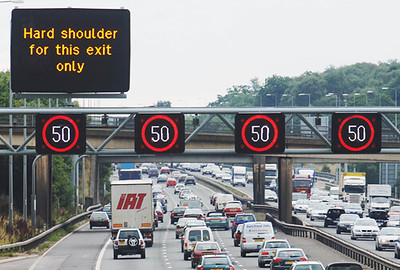 Smart motorways are designed to better manage the traffic flow and prevent the traffic bunching that can lead to multiple accidents and/or slow journey times because of the traffic congestion that is caused.
Smart motorways are designed to better manage the traffic flow and prevent the traffic bunching that can lead to multiple accidents and/or slow journey times because of the traffic congestion that is caused.
There are three types of smart motorways:
Controlled motorways
Controlled motorways have three or more lanes with variable speed limits. Effectively, these are motorways as we have always known them but with variable speed limits,
Dynamic Hard Shoulder Running schemes
Dynamic Hard Shoulder Running involves opening the hard shoulder as a running lane to traffic during busy periods to ease congestion.
Again these are like regular motorways, the difference being that there are lane indicators on the gantry signs over the hard shoulder to show whether it is available for normal driving or is closed (and only available for emergencies).
One of the worries about using the hard shoulder as a running lane is as it will create problems in the event of breakdowns. (Latest information below)
All-Lane Running schemes
On All-Lane Running Smart motorways, there is effectively no hard shoulder.
The main difference between All-Lane Running motorways and the other types is that the solid line denoting the hard shoulder has gone. Lanes are all marked equally with broken white lines.
The basic driving rule applies to keep to the left lane and only change lanes to the right to overtake or follow direction signs.
As with the dynamic hard shoulder, CCTV monitors these roads, and in the event of breakdowns or other incidents, lanes can be closed from the control room by activating the gantry lights.
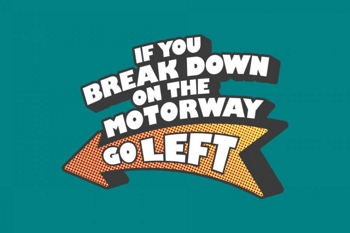 Over the years, there have been concerns about Smart Motorways. This is not a reason to avoid them, but you must be fully aware of potential dangers so that you are prepared in the event of a problem.
Over the years, there have been concerns about Smart Motorways. This is not a reason to avoid them, but you must be fully aware of potential dangers so that you are prepared in the event of a problem.
In March 2021, the UK Government launched a major safety campaign, 'Go Left'.
The campaign has not been well received by many people - as you can see from the comments on the YouTube page.
Remember, the purpose of this information is not to worry you about Smart Motorways, but to make you aware of potential dangers so that you can keep yourself safe.
First, do everything you can to avoid breakdown. Your car must be adequately serviced and fully roadworthy with correctly inflated tyres.
If you are driving a car that is not regularly serviced, does not have an MOT (which would be illegal) or have any doubts about reliability - do not drive on a Smart Motorway.
If your car breaks down and can't be moved on a Smart Motorway, there is not much you can do.
The only escape is to risk getting out of the car and making it to the safety of the verge or behind a central reservation crash barrier – but this is also dangerous and might not be an option if you have children or older people in the car.
If you break down in lane one (the nearest to the left verge), get everyone out via the passenger side doors as quickly as possible and onto the verge – preferably behind the crash barrier and twenty or thirty metres behind the car.
If you are stopped in lane 4 (where this is the outside lane), get out via the driver's side doors and into a position between the central crash barriers – again, well behind the car. This is a very dangerous place to be, especially if there is only a narrow gap between barriers – your presence will be a distraction for drivers, but being behind a crash barrier is likely to be safer than sitting in the car.
If you are young and reasonably fit, an educated guess suggests that you will probably need between 10 and 15 seconds to exit the car and make it to safety. This might sound like plenty of time to cross a road, but consider that a vehicle travelling at 80 mph will cover almost 360 metres in 10 seconds – this means that if there is any traffic in sight, there might not be enough time to cross 'live lanes' of traffic. Add to this that you need gaps in at least two lanes depending on where you break down.
The only advice if a driver or passenger can't get out is to keep seatbelts on and put on hazard lights & fog lights to make the car as visible as possible and call 999.
 The official advice is to stay in the car unless you can get out on the nearside in lane one. You can see the BBC version of the advice here but take it with a pinch of salt!
The official advice is to stay in the car unless you can get out on the nearside in lane one. You can see the BBC version of the advice here but take it with a pinch of salt!
It quotes that drivers should be able to drive to a refuge within 75 seconds, but that is probably an average taken across all Smart Motorways - some motorways have refuges that are 2.5 miles apart according to a BBC Panorama investigative programme, that's 128 seconds away at 70 mph.
Again, We stress that his information is not designed to alarm you or to create fear about Smart Motorways.
Millions of drivers use Smart Motorways safely, however, they are very dangerous in the event of an accident or breakdown. The important thing is being aware of the dangers and the advice offered in this lesson - if you are unlucky enough to have a problem the advice can save vital seconds and be a lifesaver.
You might be interested in the Panorama report video that exposed the dangers.
Government have said that they are reviewing safety procedures and Smart Motorway design.
Note: There is no quiz for this subject.
 Motorway Quiz
Motorway QuizClick here to complete the quiz for this lesson
(The page will open in a new window/tab)
You will find references for the answers in this lesson.
You can check your answers as you go along, or complete the full quiz before checking.
Leaving the check to the end is a good way to test yourself.
When you check or review your answers you will get a brief explanation of the answer.
Good Luck!